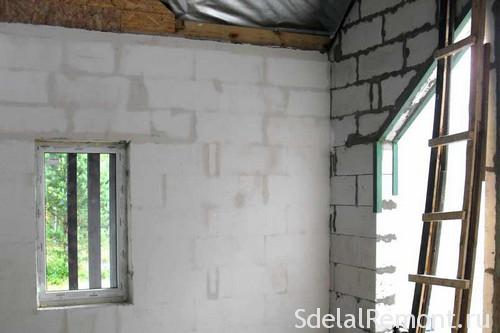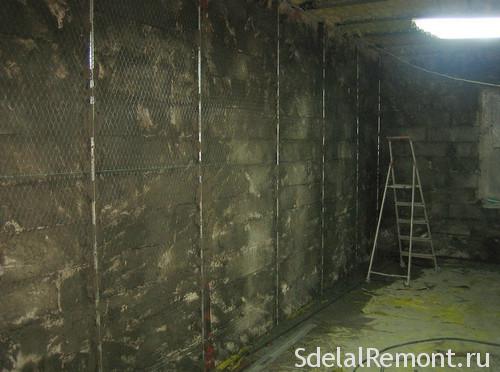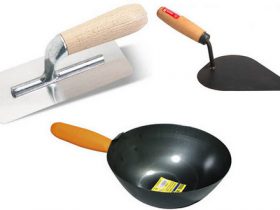Выполнение штукатурки стен из газобетона внутри жилого дома – один из лучших вариантов сохранить теплосберегающие свойства ограждающих конструкций.
Использование газобетонных блоков в качестве строительного материала – практически идеальный вариант для малоэтажного жилья. Построенные из них частные дома обладают такими преимуществами как небольшой вес (а, значит, не требуют возведения слишком прочных фундаментов), низкую теплопроводность и доступную цену. В то же время повышение влажности блоков приводит и к ухудшению его теплосберегающих характеристик, и к утяжелению конструкций. Для защиты стен обязательно требуется штукатурка стен из газобетона – иногда внешняя, но чаще всего внутренняя.
Особенности отделки
Выполняя внутреннюю штукатурку газобетона, стоит учитывать особенности этого материала и отличия от более традиционного кирпича, бетона и камня. В первую очередь, это касается ячеистой структуры блоков, которые изначально считались утеплителем, и только потом стали применяться для сооружения самих стен. За счёт открытой структуры, которая является результатом добавления в его состав специального газообразователя (алюминиевой пудры), газобетон имеет высокий уровень паропроницаемости. Эта характеристика является одной из главных при выборе материала и способа отделки.
Независимо от выбора, чем штукатурить газобетон, начинать отделочные работы следует изнутри, и только потом заниматься фасадом здания. Изменение очерёдности и выполнение сначала наружной, а только потом внутренней отделки, приводит к получению слишком высокой влажности в помещении. Выходящий (особенно, при сильном морозе) пар конденсируется в стенах на границе газобетона и отделки. Создаваемая при этом влага может привести к появлению трещин на штукатурке и отпаданию её кусков. Именно поэтому внутренние отделочные работы выполняют в первую очередь.

Выбор метода и материала
При выполнении отделочных работ штукатурка стен из газобетона внутри помещения выполняется одним из двух основных способов. Смысл первого заключается не только в сохранении, но даже в повышении паропроницаемости блоков. Второй, наоборот, предполагает полную пароизоляцию. Преимущества сохранения паропроницаемости заключаются в создании оптимального микроклимата, а варианта с изолированием стен – в сохранности наружной отделки, на которую не влияет выходящий из здания пар.
Неудачные варианты
Для штукатурки газобетона внутри не рекомендуется использовать цементный раствор. Первая причина – гладкие блоки не позволяют материалу держаться. Слой цемента быстро отпадает, и отделку приходится выполнять заново. Во-вторых, оптимальным вариантом для штукатурки блоков считается материал с таким же или большим показателем паропроницаемости по сравнению с газобетоном. У цемента эта характеристика намного ниже, что не позволяет сохранить нормальные условия внутри здания. По той же причине ответ на вопрос, можно ли штукатурить газобетон пенополистирол или пенопласт, будет отрицательным.
Кроме того, цементно-песчаный раствор имеет повышенную влажность из-за требующегося для его приготовления значительного количества воды. Газобетонные конструкции, имеющие высокий показатель водопоглощения, впитывают жидкость из отделочного материала. Качество раствора, для набора прочности которым требуется равномерное высыхание, снижается, так же как и его способность держаться на стенах. В результате на штукатурке появляются трещины, а её качество падает, приближая следующий ремонт.
Не следует выбирать для отделки газобетона внутри специальную клеевую смесь. Несмотря на то, что она разработана с учётом особенности материала, клей желательно наносить тонким слоем, не подходящим для защиты от трещин. Как только паропроницаемость блока нарушится, на поверхности тонкослойной штукатурки для газобетона из клеевой смеси сразу появятся;
- трещины;
- следы от швов;
- и даже плесень.
Паропроницаемая отделка
Выбирая вариант отделки стен из газобетона внутри помещения с сохранением естественной паропроницаемости материала, пользуются штукатурными смесями на гипсе и гипсовой шпаклёвкой. Благодаря находящейся в их составе гашёной извести и перлитовому песку через слой штукатурки легко проникает водяной пар. Ещё одно преимущество такого варианта – отсутствие необходимости грунтовать поверхность ограждающих конструкций.
Ненамного реже применяются в качестве внутренней штукатурки стен из газобетона такие смеси, в составе которых высокое содержание таких природные материалы с высокой степенью паропроницаемости:
- мела;
- мрамора;
- доломита;
- известняка.
Их показатели паропроницаемости выше по сравнению не только с внутренней, но даже с наружной штукатуркой, а высохший раствор легко затирается, приобретая идеальную белизну. Получающееся в результате покрытие имеет отличную прочность и позволяет проводить дальнейшую отделку.

Следует знать: Из-за пористой структуры бетона рекомендуется шпаклевать его только после нанесения грунтовки. Если этого не сделать, на шпаклёвке появятся трещины.
Отделка с пароизоляцией
При выборе отделки газобетона внутри помещения с устранением паропроницаемости, то есть с полной изоляцией ограждающих конструкций, одним из материалов является полиэтиленовая плёнка. Самый простой и быстрый метод его закрепления на стенах – укладка под один из отделочных слоёв. Однако скорость и удобство укладки не имеют значения, если на отделанных таким способом конструкциях образуется конденсат, а штукатурка вздувается. Более подходящим вариантом для того, чем штукатурить газобетон внутри дома, станет песчано-цементная смесь, в составе которой нет добавок в виде доломитовой муки или извести. С её помощью паропроницаемость снижается в несколько раз, однако возрастает возможность отслоения штукатурки через некоторое время.
Дополнительно снизить пароизоляцию, не слишком повлияв на качество отделки, помогут:
- масляная краска, которой покрывают стены на заключительном этапе работ;
- нанесение в качестве грунтовки газобетона 3–4 слоёв специального состава;
- использование адгезивов перед нанесением штукатурки. В этом случае можно обойтись даже без использования шпаклёвки. Адгезивные материалы имеют те же свойства и, фактически, её заменяют.
Особенности работы
Для выполнения отделки газобетона штукатуркой своими руками требуется применение тех же инструментов, которые нужны для обычного оштукатуривания. Для приготовления раствора штукатурной смеси нужна специальная ёмкость – такая как пластиковый бак или сделанное из того же материала ведро. Их размер должен быть достаточным для того чтобы разместить внутри все ингредиенты для штукатурки.
К сухой смеси, которая высыпается в бак, добавляют воду. Смесь перемешивают до нужного состояния дрелью с насадкой или строительным миксером. Определить пропорции материала и жидкости, как правило, можно по надписям на упаковках со строительными материалами.
Наносится штукатурка стен из газобетона внутри помещения путём «накидывания» с помощь ю таких инструментов как:
ю таких инструментов как:
- мастерок;
- штукатурный ковш;
- кельма.
Поверхность затирается тёркой. А лишний раствор со стены можно удалять полутером. Выравнивать стену требуется с помощью маячков, а стягивать штукатурный раствор – правилом. Ещё один инструмент, без которого не обойтись при выполнении работ – рейка длиной от пола до потолочного перекрытия. С её помощью проверяются дефекты на стенах – допустимыми считаются отклонения размером не больше 6–7 мм.
Процесс оштукатуривания
Решив вопрос, как штукатурить стены из газобетона, переходят непосредственно к выполнению работ. Они начинаются, как и все способы отделки поверхности, с подготовки основания. Блоки очищают от остатков смеси и заделывают швы между ними. Перед тем, как штукатурить газобетон внутри помещений на пористую поверхность наносится слой грунтовки.
Растворы для газобетонных блоков, предполагающие сохранение паропроницаемости, тоже
способны пропускать пар, отличаясь не только высокими гидрофобизирующими свойствами, но и возможностью укрепить ограждающие конструкции. Грунтовку требуется наносить не в один слой, а в несколько. При этом обязательно учитывается, что новое нанесение проводится только поверх полностью высохшего старого.
Далее технология штукатурки стен из газобетона включает такие этапы как:
- Закрепление сетки для армирования блоков. Из-за большого размера каждого газобетонного изделия величина их сцепления с отделочными материалами небольшая. И для повышения прочности применяют армирование материалом, в составе которой есть щёлочестойкое волокно. Можно использовать для газоблока сетки «рабица» с небольшим размером ячейки. Для её крепления требуется применение 120-миллиметровых гвоздей, неплохо вбивающихся в газобетон;
- Если армирование не используется (решать, нужна ли сетка при штукатурке газобетона, следует ещё на стадии выбора материалов), сцепление отделочных слоёв с газобетоном обеспечивается пересекающимися друг с другом бороздками, выполняемые любыми подходящими инструментами – например, ножовкой.
- Нанесение первого слоя материала (предварительно выбирается, чем лучше штукатурить газобетон) на сетку. При этом используется технология «набрызга», обеспечивающая полное заполнение ячеек газобетона, а выравнивание первого слоя не проводится, что позволяет улучшить сцепление со следующим слоем штукатурки.
При нанесении грунтующего раствора поверх черновой штукатурки газобетона требуется выдерживать толщину слоя на уровне 4–5 мм. Рекомендуется добавление в грунтовку шлакового песка. При нанесении финишного штукатурного слоя желательно применять стройматериал, в составе которого есть песок мелких фракций, повышающий гладкость блоков.
Завершающий этап
На предпоследней стадии оштукатуривания поверхность слоя штукатурки делают практически идеально ровной путём разглаживания уже высохшего раствора. Примерное время, через которое можно разглаживать штукатурку – 24 часа. Для того чтобы поверхность получалась более ровной блоки смачиваются водой.
Последний этап – малярные работы с использованием специальных красок. Для этого выбирают материалы, имеющие высокую степень паропроницаемости. После окрашивания поверх слоя краски желательно нанести гидрофобизатор, в несколько раз увеличивающий прочность и долговечность отделочного слоя.
Эксплуатационный срок получившейся внутренней отделки зависит от ряда факторов. Например, от качества отделочных материалов, которое можно определить уже по стоимости (хорошая штукатурка не будет дешёвой). Хотя не меньшее значение имеют и характеристики самого газобетона – даже дорогая штукатурка не будет достаточно хорошо держаться на низкокачественной поверхности.












